Ukrainian Long Range Aviation
The Long Range Aviation Group (Ukrainian: Авіаційна група дальньої авіації, Aviaciyna Grupa Dalnoi Aviacii); abbr. AGDA / АГДА), was a military organisation, subordinate to the Central High Command of the Ukrainian Air Force, which included the long-range aircraft of Ukraine. Ukrainian Long Range Aviation was disbanded in 2007.
| Long Range Aviation Group of the Armed Forces of Ukraine Авіаційна група дальньої авіації Збройних сил України | |
|---|---|
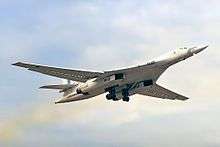 A Tu-160 in Ukrainian colours, 1997. | |
| Founded | 1992 |
| Disbanded | 2006 |
| Country | Ukraine |
| Type | Major Command |
| Part of | Ukraine Air Force |
| Headquarters | Uzyn (air base) |
| Equipment | 189 aircraft |
| Commanders | |
| First commander | Major general Bashkirov Mykhailo |
| Insignia | |
| Roundel |  |
| Fin flash |  |
| Aircraft flown | |
| Bomber | Tu-22KD, Tu-16, Tu-22M3, Tu-95, Tu-160 |
| Trainer | Tu-22UD, Tu-134UBL |
| Transport | Il-78 |
History
After the fall of the Soviet Union, the Ukrainian Air Force was left with three air armies (1,100 combat aircraft), which included 30 Tu-16 missile carriers, 33 Tu-22KD missile carriers, 30 Tu-22R reconnaissance aircraft, 36 Tu-22M3s, 23 Tu-95MSs, 19 Tu-160s, 20 Ilyushin IL-78 aerial refueling aircraft, as well as large stockpiles of missiles: 1,068 Kh-55s and 423 Kh-22s.[1][2][3]
In 1992 Ukraine also received much of the Soviet Black Sea Fleet, including the 2nd Guards Maritime Missile Aviation Division (Hvardiiske, Crimea), with three regiments of maritime attack Tu-22M2s and an independent Maritime Reconnaissance Aviation Regiment (Saki-Novofedorovka, Crimean Oblast) of Tu-22Ps. The 1995/96 edition of the Military Balance continued to list the remnant of these forces under now-Ukrainian Naval Aviation. In 1994 Tu-22M2s, Tu-16Ks and a large part of the Tupolev Tu-22Ps were put in storage and then dismantled.[4][5]
The reasons for the elimination of Ukrainian long-range bombers included:[4]
- The deep economic crisis in the Ukraine after the collapse of the USSR
- Pressure from the U.S. State Department on Ukraine
- Lack of support from production plants and design bureaus which remained in Russia
- Reduction in the size of the armed forces resulting in the loss of experienced pilots and supporting personnel
- Life expectancy of some aircraft components and assemblies had expired
Funding for the elimination of strategic aviation of Ukraine was allocated by the U.S. government as part of an agreement "to provide assistance to Ukraine in the elimination of strategic nuclear weapons and to prevent the proliferation of weapons of mass destruction", signed on November 25, 1993 between Ukraine and the United States.[1] In 2000 in the agreement was extended to 31 December 2006.[6]
Long-Range Aviation Base Places
_(UKRN)_AN1713185.jpg)
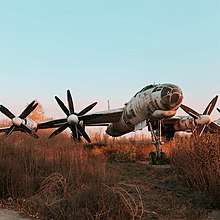
| Regiment/brigade | Base | Aircraft type | Comments |
|---|---|---|---|
| 251st Heavy Bomber Aviation Regiments | Bila Tserkva Airport | 27 Tu-16K | |
| 199th Reconnaissance Aviation Regiment | Nizhyn Air Base | ~30 Tu-22R/RDK/P/U | Last flight of the Tu-22 in July 1998. On February 22, 1999, transferred to the Ministry of Emergency Situations and renamed 300 Special Aviation Squadron MOE. |
| 1006th Heavy Bomber Aviation Regiments | Uzyn (air base) | 23 Tu-95MC | |
| 409th Aviation Regiment of tanker aircraft, | Uzyn (air base) | 21 Il-78 | Since 1993, some of the Il-78 were disposed of their refueling equipment and used as cargo aircraft, the other ones were sold to Algeria, India, Pakistan and China, where they are used for air refueling operations.[7][8] |
| 184th Guards Heavy Bomber Aviation Regiment | Pryluky Air Base | 19 Tu-160 | Unit was finally disbanded in November 2000 |
| 185th Guards Heavy Bomber Aviation Regiment | Poltava Air Base | 18 Ту-22M3, 6 Tu-16P | Unit was finally disbanded in 2006. In February 2006, at the Poltava military airfield, the last Tu-22M3 bomber Ukrainian Air Force was cut. In 2007, a museum was created on the territory of the former airbase thanks to the enthusiasm of former military pilots. |
| 341st Heavy Bomber Aviation Regiment | Ozerne Air Base | ~30 Tu-22K/KP/P/U | Last flight of the Tu-22 in 1997. In 1997-1998 Tu-22 relocated to Nizhyn Air Base where all planes was cut till 2001. |
| 260th Heavy Bomber Aviation Regiment | Stryi Air Base | 18 Tu-22M3, 23 Tu-16K | In 1993, the regiment was disbanded, Tu-22M3 relocated to Pryluky Air Base, and Tu-16 withdrawn from service. |
Gallery
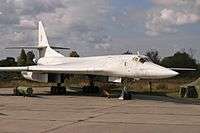 Tu-160 from 184th Guards Heavy Bomber Aviation Regiment at Poltava Air Base
Tu-160 from 184th Guards Heavy Bomber Aviation Regiment at Poltava Air Base- Tu-95MS
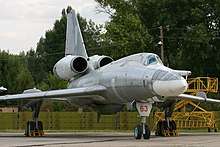 Tu-22KD
Tu-22KD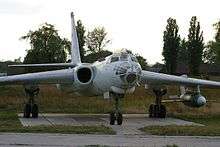 Tu-16K
Tu-16K- Tu-134UBL
 Tu-22М3 at RIAT 2000, England
Tu-22М3 at RIAT 2000, England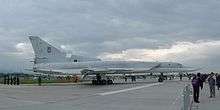 A Ukrainian Air Force Tu-22M3 at SIAD 2002 Air Show, Bratislava, Slovakia
A Ukrainian Air Force Tu-22M3 at SIAD 2002 Air Show, Bratislava, Slovakia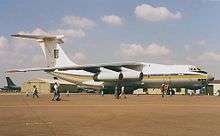
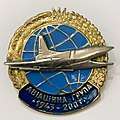 Medal Ukraine Aviation Group
Medal Ukraine Aviation Group Ukrainian Air Force Long Range Aviation shoulder sleeve insignia
Ukrainian Air Force Long Range Aviation shoulder sleeve insignia Chevron of the 185th GvTBAP
Chevron of the 185th GvTBAP Chevron of the 185th GvTBAP, approved in 1998. Used during the airshows
Chevron of the 185th GvTBAP, approved in 1998. Used during the airshows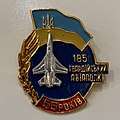 Medal 55 years of 185th GvTBAP
Medal 55 years of 185th GvTBAP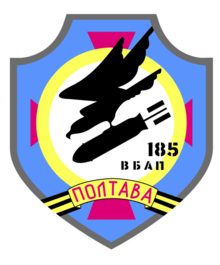 Emblem of the 185th GvTBAP.
Emblem of the 185th GvTBAP.
References
- "Ukraine will dispose of it the Tu-22M3". defense-ua.com.
- "27 января в Полтаве состоится завершающий этап Программы ликвидации тяжелых бомбардировщиков типа Ту-22М3 и авиационных ракет типа Х-22" [On January 27 in Poltava will take the final step, the elimination of heavy bombers Tu-22M3 aircraft and missiles X-22]. Ukrainian Government Portal. 26 January 2006. Retrieved 3 June 2016.
- The Military Balance. London: International Institute for Strategic Studies. 2002.
- Aviation and Time. 1996, No.5, pp.28-36.
- Holm, Michael (2016). "Red Banner Black Sea Fleet". ww2.dk. Retrieved 3 June 2016.
- "Украина разрезала 30 бомбардировщиков Ту-22 на американские деньги" [Ukraine cut 30 Tu-22 on US money]. Lenta.ru (in Russian). 29 March 2004. Retrieved 3 June 2016.
- "Судьба украинских самолетов-заправщиков Ил-78". bmpd.livejournal.com. 3 September 2016. Archived from the original on 9 November 2017. Retrieved 28 January 2019.
- "Ил-78 на Украине". airwar.ru. Archived from the original on 29 January 2019. Retrieved 28 January 2019.